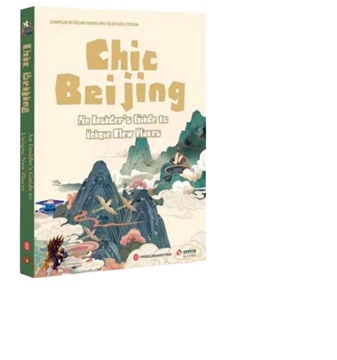
Chic Beijing: An Insider’s Guide to Unique New Places
Compiled by Beijing Radio and Television Station
Price: RMB 138
Paperback, 307 pages
Published by Foreign Languages Press & Beijing Publishing Group
If you’re planning a trip to Beijing, prepare to be swept up in a living mosaic – more than 3,000 years of history, vibrant contemporary culture, and skyline-defining architecture all fusing and flowing across a vast canvas.
This book, Chic Beijing: An Insider’s Guide to Unique New Places, allows readers to take a breathtaking journey through Beijing, the majestic metropolitan capital of China. It also unlocks doors that usually stay closed: rooftop gardens overlooking palace rooftops, micro-galleries tucked into 300-year-old courtyards, and cocktail labs where baijiu meets coffee.
Across its five chapters, the book hands you the key to some living icons: climb the Bell and Drum Towers at dusk to hear time itself toll over hutong rooftops; snag a backstage pass to the lucky-red Jixiang Theater where Peking Opera facial masks meet LED backdrops; lose yourself in Taikoo Li Sanlitun’s open-air catwalk of flagship stores and street-style lenses; then picnic on the Liangma River’s cosmopolitan waterfront as neon reflections ripple across the water like liquid silk. Each stop distills centuries of history into one exhilarating breath, proving that Beijing’s ancient soul and cutting-edge modernity don’t just coexist – they collaborate to make the city pulse with dynamism and life.
Chapter one starts from the Qianmen Street, the 600-year-old pedestrian spine that shoots due south from the Forbidden City along Beijing’s central axis. Once the ceremonial “front door” of the imperial capital, this north-south artery is now a living timeline. Claret-red trams clang past by time-honored brands still in business: Ruifuxiang’s silk bolts whisper like Ming scrolls; Changchuntang’s herbal tang drifts across mahogany drawers; Neiliansheng’s handmade cloth shoes tread the same flagstones as mandarins’ boots; Zhangyiyuan’s first flush teas scent the air with Qing-Dynasty nostalgia. And then there’s Quanjude, founded in the third year of Emperor Tongzhi (1864), where ducks are still roasted over fruit-wood flames, crowned with their lacquer-crisp skin, following a 160-year-old recipe.
One of the most famous attractions on this street is the Lao She Teahouse. Established in 1988, it was named after the renowned Chinese writer Lao She (1899– 1966) and his famous play, Teahouse. One or two waiters stand at the entrance of the teahouse, greeting and beckoning passersby to come inside. Visitors can taste authentic Beijing palace refreshments and traditional snacks, and also enjoy a two-hour show featuring a variety of performances, including Peking Opera, Beijing drum music, acrobatics, and dancing.
Chapter two spotlights the Jixiang Theater – Beijing’s “sky palace of opera.” Suspended on the eighth floor of a Wangfujing shopping mall, originally founded in 1906 and re-opened in 2021 beneath hand-painted coffered ceilings and cutting-edge acoustics that let Peking- and Kun-opera stars sing unplugged. In its first season alone the 330-seat gem staged over 500 performances.
Chapter three takes readers on a ride through Beijing’s most energetic playgrounds: Taikoo Li Sanlitun, where glass-walled flagships and street-style lenses turn a former diplomats’ quarter into a 24-hour runway; New Shougang, the blast furnace turned into a creative park that hosts e-sports arenas under cantilevered steel; the Longfu Temple enclave, with centuries-old hutong lanes now threaded with indie cafés and midnight jazz; Beijing WTown, a canal-laced mountain resort that stages lantern festivals beneath the Simatai Great Wall; and Beijing Happy Valley, a scream-machine theme park that loops roller-coasters over a horizon tiled with temple rooftops.
Chapter four explores the scrumptious feast sprinkled across the majestic city. It starts on Guijie, or “Ghost Street,” where scarlet lanterns sway above simmering midnight hotpot and crawfish that stain fingers crimson for the fearless and the famished. Dawn swings you to Daoxiangcun’s flagship, a bakery founded in 1895, whose walnut crisps and rose-filled moon-cakes still taste like they were taken from an imperial pantry. When summer turns merciless, duck into the Forbidden City’s chilly 18-degree Celsius ice cellar, a Qing-Dynasty refrigerator turned misty sanctuary where emperors once chilled melons and now one can chill the soul. End the day on Yangmeizhuxie Street, half hipster alley sprouting neon cafés, a half hushed canal where willows mirror old whitewalls.
The last chapter leads readers to Beijing’s green lungs, revealing how an empire-sized capital breathes with its rivers and trees. Cycle the China National Botanical Garden for dawn-lit peony valleys that once bloomed only for emperors. Kayak or picnic along Wenyu Riverside Park, where reed beds echo with migratory birds that use the flyway older than the Great Wall. Follow the Liangma River’s glimmering boardwalks at night, where office towers glitter in clean water. Head east to Grand Canal Forest Park and jog beneath 3,000-year-old canal banks now lined with lotus ponds and firefly meadows. Finally, stand on the Park’s meadow roof to enjoy a 360-degree panoramic sunset that melts ancient hutong roofs into a horizon of poplars.
Beijing, where the pulse of history syncs with the rhythm of the new, invites travelers from afar to step into its unfolding story and craft their own unforgettable chapter.